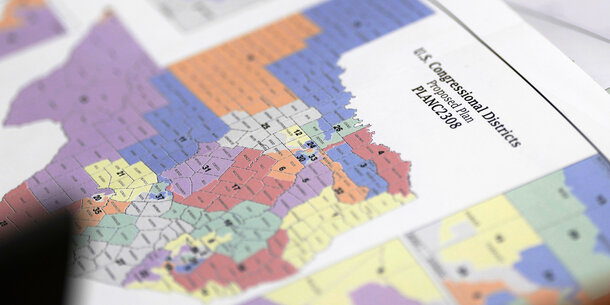Every 10 years, states redraw the boundaries of their congressional and state legislative districts after the census. Who does the line drawing varies by state.
The way districts are drawn can have a big impact on not just incumbent politicians, but on the communities they represent. It can influence who wins elections, how political power is distributed, which communities are represented, and what laws are passed. This creates a powerful incentive to manipulate district lines for political gain. Over time, these manipulations have grown increasingly common and sophisticated.
However, recent years have seen a significant growth in efforts to protect the redistricting process from abuse. While the vast majority of states continue to let their legislatures draw districts, there has been a growing movement toward alternative approaches to map drawing. Citizen-driven ballot initiatives led to the passage of redistricting reforms in Arizona in 2000 and in California in 2008 and 2010. Since then, voters in Colorado, Michigan, Missouri, New York, Ohio, Virginia, and Utah have also adopted changes to improve the redistricting process (although some of those reforms in some states have since been rolled back).
The following charts and maps show what entity is currently responsible for redistricting in each state.
I. Map Drawers by Type
Line-drawing responsibility in states falls into four broad categories: states where legislatures draw maps, states that have advisory bodies draw maps for legislative consideration, states that use independent commissions to draw maps, and states that use some other form of commission.
State Legislatures
In around half the states, legislatures continue to be responsible for drawing and passing redistricting plans. Generally, plans need only a simple majority in each chamber of the legislature to pass and are subject to veto by the governor. However, Connecticut requires a two-thirds majority in each house to approve a plan, and there is no gubernatorial veto for legislative redistricting plans in Florida, Maryland, and Mississippi and no gubernatorial veto for either legislative or congressional redistricting plans in Connecticut and North Carolina.
In the 2010 redistricting cycle, legislatures drew congressional maps in 35 states and legislative maps in 33 states.
Advisory Bodies
In eight states, advisory bodies recommend redistricting plans to the legislature, which then decides whether to approve them. In seven of the eight states, the body responsible for recommending maps is an advisory commission consisting of legislators, non-legislators, or a mix of the two. In Iowa, however, the state’s nonpartisan Legislative Services Agency draws and recommends maps to the legislature, with input from an advisory commission. In New York, Virginia, and New Mexico, advisory commissions are required to include independents and/or members of third parties, but in other states, advisory commissions generally consist only of members of the two major parties.
Once legislatures receive recommended maps, the process for consideration of maps varies greatly. In Maine, New Mexico, Rhode Island, Utah, and Vermont, legislatures are free to completely ignore advisory commission maps. By contrast, in New York, Virginia, and Iowa, maps submitted by the advisory body must be voted upon, without modification, on an up-or-down basis. In these states, if the legislature rejects the map, the advisory body submits a second proposed map, which also is voted upon on an up-or-down basis. If the second map is also rejected, legislatures in New York and Iowa then have free rein to enact their own map. In Virginia, by contrast, if the legislature does not approve either the first or second advisory commission map, responsibility for drawing and enacting a map defaults to the Virginia Supreme Court.
In the 2010 redistricting cycle, Iowa, Maine, and Rhode Island used an advisory commission to draw both legislative and congressional maps, and Vermont used an advisory commission to draw legislative maps. This decade, they will be joined by advisory commissions in New Mexico, New York, Utah, and Virginia, which will draw both legislative and congressional maps. Advisory commissions have become an increasingly popular reform in states without citizen-initiated ballot initiatives where reforms of the redistricting process must go through legislatures.
Independent Commissions
Independent commissions are made up of members who are neither public officials nor current lawmakers and are selected with the help of a screening process conducted by an independent entity. That screening process vets would-be commissioners for conflicts of interest and, in some states, also makes an assessment of applicants’ skills, qualifications, and aptitude.
All current independent commissions include independents and/or members of third parties as well as members of the two major parties. Independent commissions have the authority to enact final maps.
In the 2010 redistricting cycle, only two states used independent redistricting commissions to draw legislative and congressional maps: Arizona and California. This decade, they are joined by independent commissions in Colorado and Michigan, which likewise will draw both legislative and congressional maps.
Political Appointee and Politician Commissions
Unlike independent commissions, political appointee commissions and politician commissions are more closely connected to the political process.
Members of political appointee commissions are nonelected officials, but are directly selected by elected officials or, in some states, by political parties. In general, political appointee commissions have far fewer conflict of interest rules than independent commissions, and members are often picked precisely because of their close ties to the political process or connections with elected officials. Politician commissions are even more tied to the political process, consisting of actual legislators and/or statewide officials. Virginia uses a hybrid of a political appointee and politician commission. Like independent commissions, political appointee and politician commissions have the authority to enact final maps.
Depending on how political appointee and politician commissions are structured, bipartisanship can be required in order to pass a map. However, while in some states, membership on a political appointee or politician commission is evenly divided between the major parties, others allow members of one party to hold a majority of seats on the commission, or even to hold all the seats entirely. In Alaska, for example, the commission tasked with drawing maps currently has no Democrats on it. Similarly, Arkansas’s legislative maps are drawn by a three-member commission comprised of the governor, secretary of state, and attorney general, all of whom are currently Republicans.
No additional states have adopted political appointee commissions or politician commissions since the 2010 redistricting cycle, though Ohio expanded the politician commission it uses to draw legislative maps to include lawmakers in addition to statewide officials.
II. Map Drawers by Political Control
The fairness of maps will depend not only on the type of entity drawing the map but on whether one party is able to assert sole control over the process. Although, in general, commissions and other non-legislative map drawing processes require bipartisanship, that is not always the case. The tables below look at political control of the process in the 2021–22 cycle of redistricting.
Compared to the 2010 round of legislative redistricting, the GOP controls one more state, Democrats still control 9 states, and 17 states have no one-party control. In 2020, the GOP has control over congressional redistricting in 10 fewer states and Democrats control two more states. Sixteen states have split or independent control of congressional redistricting.





